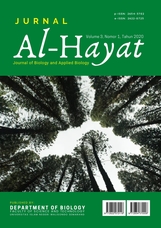Perbandingan Jumlah Total Bakteri pada Penggunaan Wadah Penyimpanan Air Susu Ibu (ASI) yang Berbeda
Main Article Content
Abstract
Downloads
Article Details
The copyright of the received article shall be assigned to the journal as the publisher of the journal. The intended copyright includes the right to publish the article in various forms (including reprints). The journal maintains the publishing rights to the published articles. Authors are allowed to use their articles for any legal purposes deemed necessary without written permission from the journal with an acknowledgment of initial publication to this journal.
The work under license Creative Commons Attribution-ShareAlike 4.0 International License.
References
Amezquita, A., Brashears, M.M. (2002). Competitive inhibition of Listeria monocytogenes in ready to eat products by lactic acid bacteria. Journal Food Prot. 65, 316-325.
Anggreani, Y.D.A., Mariani, N.P., Okarini, I.A. (2019). Fisikokimia dan mikrobiologi susu kambing peranakan etawah selama penyimpanan suhu ruang. Journal of Tropical Animal Science, 7(1), 9-20.
Arisman. (2004). Gizi dalam Daur Kehidupan. Penerbit Buku Kedokteran EGC. Jakarta.
Arslanoglu, S., Bertino, E., Tonetto, P., Nisi, G., Ambruzzi, A.M., Biasini, A., Profeti, C., Spreghini, M.R., Moro, G.E. (2010). Guidelines for the establishment and operation of a donor human milk bank. Journal of Maternal-Fetal and Neonatal Medicine. 23(2), 1-20.
Chang, Y., Chen, C., Lin, M. (2012). The Macronutrient in Human Milk Change after Storage in Various Containers. Pediatrics and Neonatology. 53, 205-209.
Damayanti, S. (2018). Pengaruh lama penyimpanan Air Susu Ibu (ASI) terhadap jumlah bakteri Coliform. Skripsi. Fakultas Sains dan Teknologi Universitas Islam Negeri Alauddin Makasar.
Fernandez, L., Langa, S., Martin, V., Maldonado, A., Jimenez, E., Martin, R., Rodriguest, J.M. (2013). Origin and potential roles in health and disease. Journal Pharmacologial Research. 69, 1-10.
Kementrian Kesehatan Republik Indonesia. (2015). Rencana Strategis Progam Direktorat Jenderal Bina Gizi dan KIA.
Khikmah, N. (2015). Uji antibakteri susu fermentasi komersial pada bakteri patogen. Jurnal Penelitian Saintek, 20(1), 45-52.
Monika, F.B. (2014). Buku Pintar ASI dan Menyusui. Noura Books (PT Mizan Publika). Jakarta.
Suardana, I.W. (2009). Higiene Makanan. Udayana University Press. Denpasar.

